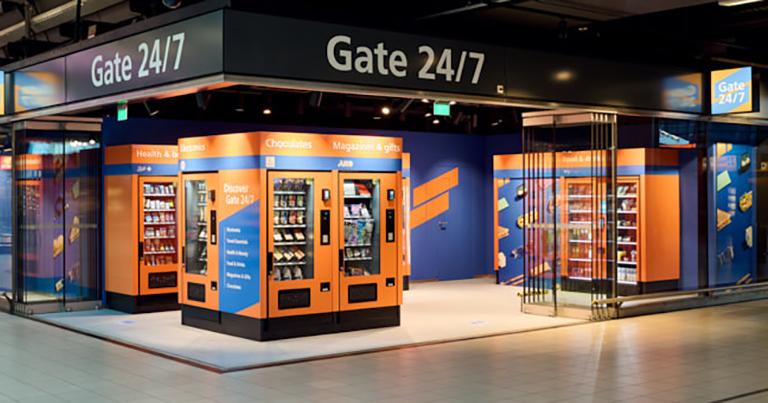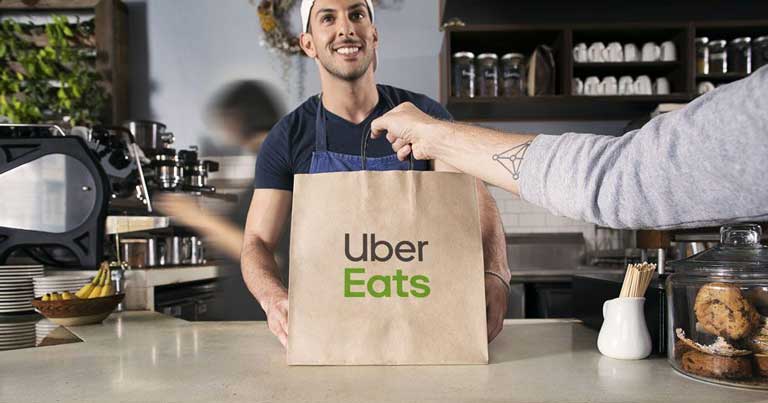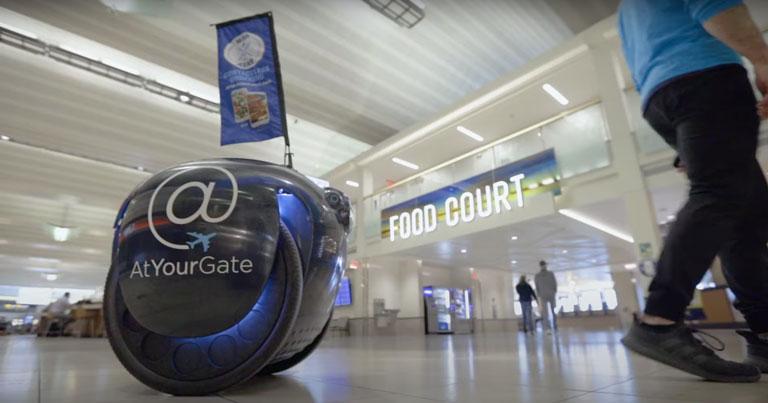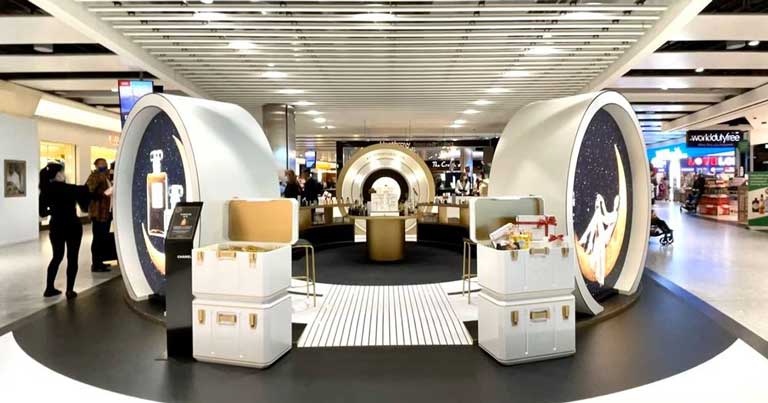5 examples of commercial innovation at airports – pre-ordering apps, delivery robots, self-service shops, immersive experiences & more
The following article was published by Future Travel Experience
FTE highlights some of the most recent innovations in the airport F&B and retail space – from 24/7 contactless shopping to immersive experiences.
With the negative impacts of COVID-19 on commercial revenue streams, it is more important than ever for airports to come up with new ways to diversify their offering. In recent months, airports and their stakeholders have turned to automation, self-service, mobile and digital technologies to create a more contactless and efficient passenger experience, while also driving sales and increasing spend at the airport terminal. Here, we highlight some of the most recent innovations in the airport F&B and retail space.
24/7 contactless shopping

Self-service technologies are changing the way consumers interact with high-street retailers, and this trend is now becoming increasingly popular at the airport terminal. For example, last week Amsterdam Airport Schiphol launched a six-month pilot of a new self-service shop concept, called Gate 24/7. The shop has 10 vending machines, each containing a different range of products. The selection of items comes from eight retailers already located at Schiphol Plaza.
As the name suggests, the shop is open 24/7, with the broad product offer intended to cater to Schiphol Plaza’s diverse customer base. This includes food and drink, beauty products, electronics, and last-minute necessities. Customers can select their choice and use contactless payment at the vending machines. Carla Laurs-Hoogvorst, Retail Manager, Amsterdam Airport Schiphol, said: “We believe that this is the future. The priority is to offer our visitors speed and convenience, and this new shop and service responds to that in a way that is accessible for our visitors and partners.”
Elsewhere, JFKIAT, the operator of Terminal 4 at John F. Kennedy International Airport, launched a new multi-brand automated retail concept, in partnership with Hudson. Located next to Five Borough Food Hall in T4, the new concept creates a contactless, 24/7 shopping destination with an array of both globally recognised brands and local products for travellers to choose from.
Another example of a more contactless shopping experience is Hudson Nonstop’s Amazon’s Just Walk Out technology stores in Dallas Love Field Airport (DAL) and Chicago Midway International Airport. Travellers are able to seamlessly enter the Hudson Nonstop store with a swipe of their credit card or using “Tap to Pay”, take the products they’re looking for, and then walk out of the store. The store merchandising layout provides visibility to essential products needed for the travel journey.
Mobile pre-ordering

The mobile food, drink and retail pre-order trend at airports isn’t new, but it has become increasingly popular at airports around the world during the COVID-19 pandemic. A number of airports, particularly in the US, have in the past few years introduced mobile ordering services for food & beverage and retail outlets. The likes of Chicago Midway, Minneapolis-Saint Paul, Boston Logan, Philadelphia, Dallas Fort Worth, and Tampa international airports have enabled food and drink delivery options via relevant airport, airline and day-of-travel channel partner websites. The system is enabled by Grab Airport Marketplace technology, an enterprise self-service platform for hospitality developed by Servy, and its partner delivery app, AtYourGate.
Meanwhile, Toronto Pearson Airport has enjoyed a successful partnership with Uber Eats and recently expanded the offering and enhanced the functionality of the in-terminal food delivery service, first introduced in 2019. As part of the enhancements, the Uber Eats app now automatically detects when a user is at Toronto Pearson and brings up a screen that lets them know food is available for pickup at the airport.
Elsewhere, Dubai Airports introduced a new regional first mobile food, beverage and retail ordering service at Dubai International Airport (DXB), launched in partnership with Dubai Duty Free and Servy. Passengers travelling from DXB’s Terminal 3, B and C gates, can access the new DXB&more service via the WOW-fi landing page, QR codes around the airport or DXBmore.com. Eugene Barry, EVP Commercial at Dubai Airports, who championed the implementation of the proposition said that the objective is to “create and test new ways of communicating with travellers before, during and after their journey with us, and raise awareness of the full range of shopping, dining, and hospitality experiences across our airport by integrating all of these channels on a single platform, while speaking directly to the consumer”. Dubai Airports also said that the ultimate ambition would be for DXB&more to become “an all-encompassing digital DXB experience, bringing together digital entertainment partners, more shopping and live experiences to guests already in the airport and those who are due to travel”.
Airports in Europe have also been quick to adopt the new trend with Schiphol introducing a new Click & Collect service, allowing passengers to view and reserve products online from the comfort of their home.
Delivery robots and automation

Some airports have taken their in-terminal food order programmes to another level by bringing in delivery robots to assist customers and staff alike. Recently, Cincinnati/Northern Kentucky International Airport (CVG), launched a fleet of fully autonomous delivery robots for food and retail. The Ottobots, operated by Ottonomy, enable passengers to order contactless delivery directly to their location at the airport’s Concourse B, delivered by an autonomous robot. Customers can select grab and go, beverage and travel items sold at select retail stores operated by Paradies Lagardère via orderatcvg.com on mobile devices.
CVG has also trialled a new robot, called Gita, by AtYourGate in collaboration with Piaggio Fast Forward. The robot has been adopted by a number of other airports in the US, including JFK, Philadelphia, Minneapolis-Saint Paul, San Francisco, Salt Lake City and Seattle-Tacoma. The rolling droids use visual sensing technology to follow the AtYourGate delivery staff members to reach their customers at their gate. CVG’s Senior Manager of Strategic Innovation, Naashom Marx, recently told FTE: “We hope to see more automation in the US. The next generation not only craves automation; they expect it to be the norm. Even this small following robot can eventually lead to adoption of self-driving cars and more.”
Digital e-commerce

Last year, JFKIAT pioneered what it calls “one of the first fully integrated, online and offline premium shopping experiences in the United States”. The airport achieved that by setting up a digital e-commerce platform in partnership with Inflyter and DFS Group, which enables travellers flying through T4 to purchase duty free items online before arriving at T4, or while waiting for their flight.
In Canada, Toronto Pearson Airport has become the first airport to launch a new e-commerce platform, called The Shops at Pearson. The online retail experience, developed in partnership with Dufry, will allow customers to access an exclusive selection of premium designer products that were previously only available to travellers at Toronto Pearson Airport. Customers will be able to get their items delivered straight to their homes, with delivery currently only available in Ontario.
Combining physical in-terminal shopping with digital e-commerce can create a wealth of insights for airport retailers to better understand customer behaviour. Consumers are already becoming more used to sophisticated levels of personalisation when they shop online, so it’s imperative for airports to find ways to build on the data they have and use it to create more tailored passenger experiences.
Creating immersive experiences

While online shopping has become increasingly prevalent in people’s everyday lives, we can’t ignore the power of physical shops. Even e-commerce giants like Amazon are realising the value of physical retail. The company has already opened a number of fresh grocery stores, bookstores and hair salons with plans to open departments stores, and its first-ever clothing shop. The big differentiator for brands here will be to create immersive, one-of-a-kind shopping experiences, utilising high-technology to connect the physical and digital worlds.
A recent example of an airport that is tapping into the immersive/experiential retail trend is Heathrow Airport, which partnered with Chanel, Dufry and JCDecaux to launch a No 5 Spaceship activation in the departure lounge at Terminal 5 before the Christmas period last year. The activation includes a Find No 5 game for consumers, and sells the brand’s fragrance line as well as a curated offering of skincare and make-up products. An augmented reality (AR) digital screen allows shoppers to virtually try on products, with the pop-up being the only travel retail location to sell Chanel’s advent calendar. The pop-up has been seen as a great “advert for travel retail” and a “vote of confidence” from brands such as Chanel for airports such as Heathrow, commented Heathrow’s Airport Retail & Property Director Fraser Brown, who is also part of FTE’s Advisory Board.
FTE World Airport Retailing Summit to drive disruption in airport commercial approaches

The airport retail industry is in a dire need for revolution and to drive the discussion forward, FTE is excited to this year launch the brand-new FTE World Airport Retailing Summit, which promises to be the most adventurous and energetic airport retail convention ever, and which will put technology at the heart of the airport retail proposition.
Taking place on 7-9 June 2022 in Dublin, this event is co-located with FTE Ancillary – the world’s leading gathering of commercial airline executives, so for the first time ever we will bring together under one roof executives representing every type of industry stakeholder globally to help establish creative new ways of working together collaboratively to create more revenues for all to share in.
Following the pandemic the time is right to bring the world’s airports, and their partners, together to share best practice, new ideas and knowledge on scaling disruptive new approaches that drive new levels of conversion with passengers through digital means.
The summit has been developed in close collaboration with our new advisory board members from Heathrow Airport, Budapest Airport, Auckland Airport, iGA Istanbul Airport, Vantage Airport Group, MAGO and Vienna Airport, and among the confirmed speakers are Robert Carey, President, Wizz Air, and Ersin Inankul, Chief Digital & Commercial Officer, İGA İstanbul Airport. Visit our dedicated show website to find out more here.
Article originally published here:
5 examples of commercial innovation at airports – pre-ordering apps, delivery robots, self-service shops, immersive experiences & more
from Future Travel Experience https://ift.tt/4XBhMTb
Comments
Post a Comment